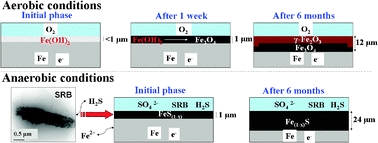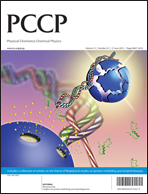Insight into the mechanism of carbon steel corrosion under aerobic and anaerobic conditions†
Abstract
We particularly focused our study on identifying the corrosion products formed at 30 °C on carbon steel under aerobic and anaerobic conditions and on following their evolution with time due to enhanced microbial activity under environmental and geological conditions. The nature and structural properties of corrosion products were investigated by scanning electron microscopy/energy dispersive X-ray spectroscopy (SEM/EDS), X-ray diffraction (XRD) and confocal micro-Raman spectroscopy. Structural characterisation clearly showed the formation of iron oxides (magnetite and maghemite) under aerobic conditions. Under anaerobic conditions, the first corrosion product formed on the steel surface was nanocrystalline mackinawite, which was then followed by a fast transformation process into the pyrrhotite phase, and the Raman spectrum of monoclinic pyrrhotite was proposed for the first time. Finally, this study also shows that in the context of geological disposal of radioactive waste, the corrosion of carbon steel containers in anoxic and sulphidogenic environments sustained by sulphate-reducing bacteria may not be a problem notably due to the formation of a passive layer on the steel surface.


 Please wait while we load your content...
Please wait while we load your content...